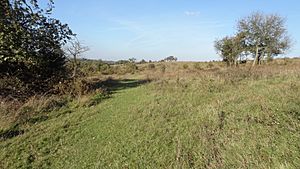Farthing Downs facts for kids
| Site of Special Scientific Interest | |
 |
|
| Area of Search | Greater London |
|---|---|
| Interest | Biological |
| Area | 53.3 hectares |
| Notification | 1987 |
| Location map | Magic Map |
Farthing Downs is a large open area in Coulsdon, located in the London Borough of Croydon. It's a great place for outdoor activities. This land, along with Eight Acres Common and New Hill, is looked after by the Corporation of London. The Corporation of London is a special local government body that manages many historic sites and open spaces in and around London.
Farthing Downs and Eight Acres Common are part of a bigger area called the Farthing Downs and Happy Valley Site of Special Scientific Interest. This means the area is very important for its nature and wildlife. Nearby, Happy Valley Park is another green space owned by Croydon Council. Farthing Downs is also a scheduled monument, which means it's a nationally important historical site protected by law.
This area is a long stretch of grassy hills, known as downland, with small patches of very old woodlands. It's the biggest natural downland area left in Greater London. The chalky soil and natural grasslands here are home to many rare plants. Some of these plants are very hard to find anywhere else in the country. For example, the wildflower called greater yellow-rattle is found here. This plant is specially protected by law, and Farthing Downs and Happy Valley have most of the greater yellow-rattle plants in Britain.
Contents
Discovering Farthing Downs' Past
Farthing Downs has a long and interesting history. People have lived and used this land for thousands of years.
Ancient Life and Farming
Archaeologists have found signs that people lived here as far back as the Neolithic period. This was a time when humans started farming and building permanent settlements. Later, during the Iron Age, people created a system of fields at the northern end of Farthing Downs. Farming continued here during the Roman period, up until about the second century AD. After that, the land was mainly used for grazing animals. You can still see the old banks of an Iron Age or early Roman enclosure system. This system included a central trackway, and you can even see the remains of old cart ruts from long ago.
Anglo-Saxon Burials
Farthing Downs is also home to sixteen Anglo-Saxon burial mounds, called barrows. These are found in two groups in the middle and northern parts of the site. These barrows were first explored in 1871 by John Wickham Flower. They were looked at again in the 1940s by Brian Hope-Taylor. More recently, in 2005 and 2006, new excavations were done by Barry Taylor from English Heritage and Amy Gray Jones from the Museum of London Archaeology Service.
Barry Taylor, an expert on ancient sites, said that Farthing Downs is one of the most amazing ancient settlement sites he has worked on. He noted that the earth and chalk banks, which were once tracks and boundaries in the Iron Age, are still visible today. These ancient remains have fascinated people for hundreds of years. They even inspired the Anglo-Saxon communities who lived here to bury their leaders along these old earthworks.
Visiting Farthing Downs
Farthing Downs is easy to visit. You can get there from Downs Road. Ditches Lane also crosses through the site, making it easy to explore. The London Loop walk, a long-distance walking path around London, also passes through Farthing Downs. It's a great place for a walk and to enjoy nature.
Caring for the Grasslands
To keep the chalk grassland healthy at Farthing Downs, sheep and cattle are allowed to graze there. The Corporation of London brought back this practice. They did this because the number of rabbits, which used to graze naturally, had gone down. Also, past corn farming had damaged the land.
Without proper grazing, stronger plants would take over, and the variety of different plants and animals (biodiversity) would decrease. In the past, shepherds would clear away bushes and trees for their animals to keep the grasslands open. Today, the bushes and scrub at Farthing Downs are important habitats for many bird species. So, the spread of these bushes is carefully managed. They are not completely cleared, because they provide a home for important wildlife.

